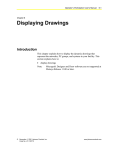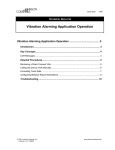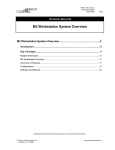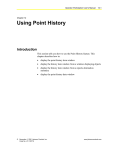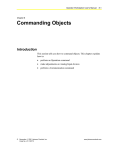Download Operator Workstation User`s Manual: Online Generation Overview
Transcript
Operator Workstation User’s Manual 1-1 Chapter 1 Online Generation Overview Introduction Online generation is the process performed at the Operator Workstation (OWS) to set up or modify a database. Setting up a database means defining the networks, devices, Personal Computer (PC) groups, systems, and objects that make up the facility. For example, when defining a network, you specify the type of connection between the network and the OWS: N1-Direct, NC-Dial, or NC-Direct. When defining a system, specify the system name, report group, and host Network Control Module (NCM). When defining software and hardware objects, specify values for the object attributes. For example, specify display units for binary objects and alarm limits for analog objects. Online generation can be performed at two stages: when the Building Automation System (BAS) is initially set up and when additions or changes are made to the facility. During initial setup, use definition windows and dialog boxes to define new items. Use Focus windows to view and modify existing definitions. To define databases offline, use Data Definition Language (DDL) and Graphic Programming Language (GPL). For detailed information on DDL and GPL, refer to the DDL Programmer’s Manual and the GPL Programmer’s Manual. © November 1, 2001 Johnson Controls, Inc. Code No. LIT-120143 www.johnsoncontrols.com 1-2 Operator Workstation User’s Manual Key Concepts Online Generation The OWS requires the entry of a Level 1 or 2 password to perform online generation. As part of the minimum database, the OWS provides a default Level 1 password. Use the default password to log onto the OWS and define a new password. Give the new password a level of 1 (the system must always have at least one Level 1 password). Then delete the default password. Always define items in the proper order, from highest to lowest level of organization. For example, define networks before PC groups, define PC groups before systems, and define systems before objects. After making changes to the database, perform an upload. Uploading copies the operational database (the database altered during Online Generation) to the archive database stored at the OWS. Because the archive database is the master copy, upload often. Minimum Database The OWS provides the following minimum database: • one PC, N1-Direct • one NCM • one network, N1-Direct • default password database • one system “SYS” • 16 report access groups This minimum database provides a foundation and allows the user to add as many new items (networks, PC groups, systems, and objects) as the facility requires, or delete items that are not required by the facility. Operator Workstation User’s Manual 1-3 Detailed Procedure Performing Online Generation Perform Online Generation steps in the following order: 1. Log on using the default password, define a new Level 1 password, and delete the default password. 2. Modify the minimum database to meet the specific requirements of your facility. 3. Define networks. See the Defining Networks chapter (LIT-120144) in this manual. 4. Define devices (for example, OWS, NCM, Printer, etc.). See the Defining Devices chapter (LIT-120145) in this manual. 5. Define PC groups. See the Defining PC Groups chapter (LIT-120146) in this manual. 6. Define the systems within the PC groups. See the Defining Systems chapter (LIT-120147) in this manual. 7. Define software models. See the Defining Software Models chapter (LIT-120148) in this manual. 8. Define the hardware objects within the systems. See the Defining Objects chapter (LIT-120149) in this manual. 9. Define hardware objects before software objects because software objects must be assigned to an existing hardware system and object name. 10. Define the software objects. 11. Perform the additional Online Generation tasks in any order (define passwords, define report/access groups, create alarm messages, define graphics, etc.). 12. Upload the modified databases (NCM and global) to make sure the archived versions (master copies) stored at the OWS are kept up to date.



